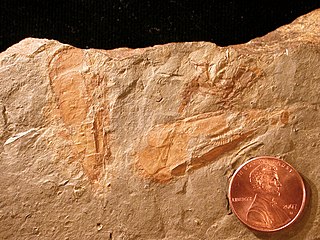
Hyoliths are animals with small conical shells, known as fossils from the Palaeozoic era. They are at least considered as lophotrochozoan, and possibly being lophophorates, a group which includes the brachiopods, while others consider them as being basal lophotrochozoans, or even molluscs.
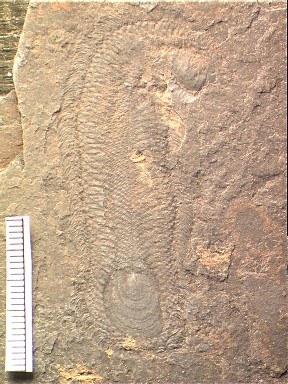
The halkieriids are a group of fossil organisms from the Lower to Middle Cambrian. Their eponymous genus is Halkieria, which has been found on almost every continent in Lower to Mid Cambrian deposits, forming a large component of the small shelly fossil assemblages. The best known species is Halkieria evangelista, from the North Greenland Sirius Passet Lagerstätte, in which complete specimens were collected on an expedition in 1989. The fossils were described by Simon Conway Morris and John Peel in a short paper in 1990 in the journal Nature. Later a more thorough description was undertaken in 1995 in the journal Philosophical Transactions of the Royal Society of London and wider evolutionary implications were posed.
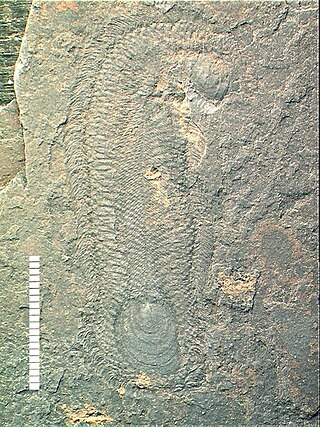
Halwaxiida or halwaxiids is a proposed clade equivalent to the older orders Sachitida He 1980 and Thambetolepidea Jell 1981, loosely uniting scale-bearing Cambrian animals, which may lie in the stem group to molluscs or lophotrochozoa. Some palaeontologists question the validity of the Halwaxiida clade.
The small shelly fauna, small shelly fossils (SSF), or early skeletal fossils (ESF) are mineralized fossils, many only a few millimetres long, with a nearly continuous record from the latest stages of the Ediacaran to the end of the Early Cambrian Period. They are very diverse, and there is no formal definition of "small shelly fauna" or "small shelly fossils". Almost all are from earlier rocks than more familiar fossils such as trilobites. Since most SSFs were preserved by being covered quickly with phosphate and this method of preservation is mainly limited to the late Ediacaran and early Cambrian periods, the animals that made them may actually have arisen earlier and persisted after this time span.

Brachiopods, phylum Brachiopoda, are a phylum of trochozoan animals that have hard "valves" (shells) on the upper and lower surfaces, unlike the left and right arrangement in bivalve molluscs. Brachiopod valves are hinged at the rear end, while the front can be opened for feeding or closed for protection. Two major categories are traditionally recognized, articulate and inarticulate brachiopods. The word "articulate" is used to describe the tooth-and-groove structures of the valve-hinge which is present in the articulate group, and absent from the inarticulate group. This is the leading diagnostic skeletal feature, by which the two main groups can be readily distinguished as fossils. Articulate brachiopods have toothed hinges and simple, vertically-oriented opening and closing muscles. Conversely, inarticulate brachiopods have weak, untoothed hinges and a more complex system of vertical and oblique (diagonal) muscles used to keep the two valves aligned. In many brachiopods, a stalk-like pedicle projects from an opening near the hinge of one of the valves, known as the pedicle or ventral valve. The pedicle, when present, keeps the animal anchored to the seabed but clear of sediment which would obstruct the opening.
Tumulduria is a Cambrian small shelly fossil. It is phosphatic, and approximately bilaterally symmetrical. It was first described by Missazhevskii from the Tommotian Stage of the Aldan River. It represents part of a pateriniid brachiopod.
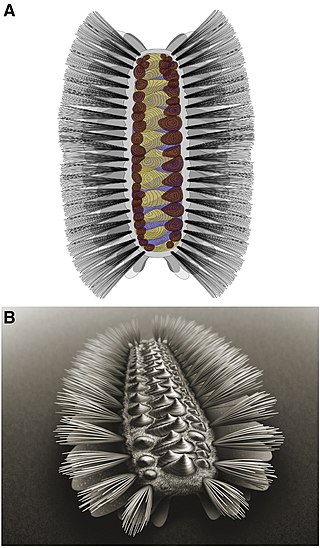
Tommotiids are an extinct group of Cambrian invertebrates thought to be early lophophorates.

The origin of the brachiopods is uncertain; they either arose from reduction of a multi-plated tubular organism, or from the folding of a slug-like organism with a protective shell on either end. Since their Cambrian origin, the phylum rose to a Palaeozoic dominance, but dwindled during the Mesozoic.
Anabarella is a species of bilaterally-flattened monoplacophoran mollusc, with a morphological similarity to the rostroconchs. Its shell preserves evidence of three mineralogical textures on its outer surface: it is polygonal near the crest of the shell, subsequently changing to both spiny and stepwise. Its internal microstructure is calcitic and semi-nacreous. Its name reflects its provenance from Anabar, Siberia. It has been interpreted as ancestral to the rostroconchs, and has been aligned to the Helcionellidae.
Stenothecoida is a taxon of bivalved fossils from the Early to middle Cambrian period. They look a bit like brachiopods or bivalve molluscs.
Mobergella is a millimetric Lower Cambrian shelly fossil of unknown affinity, usually preserved in phosphate and particularly well known from Swedish strata, where it is diagnostic of lowermost Cambrian rocks. Originally interpreted as a monoplacophoran, the circular, cap-shaped shell resembles a hyolith operculum, with concentric rings on its upper surface, and seven pairs of internal muscle scars. It is never found in association with a conch, and its affinity therefore remains undetermined. Nevertheless, its heavy musculature does seem to indicate that it functioned as an operculum.

Allonnia is a genus of coeloscleritophoran known as complete scleritomes from the Middle Cambrian Burgess Shale. It is also a constituent of the small shelly fauna.
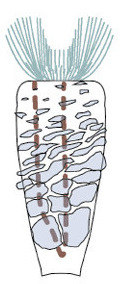
Eccentrotheca is a genus of "tommotiid" known from Cambrian deposits. Its sclerites form rings that are stacked to produce a widening-upwards conical scleritome. Individual plates have been homologized with the valves of brachiopods, and a relationship with the phoronids is also likely at a stem-group level. Its pointed end terminated in a stub that probably fastened it to a hard sea floor; its open end has been interpreted as a filter-feeding aperture.
Mickwitziids are a Cambrian group of shelly fossils with originally phosphatic valves, belonging to the Brachiopod stem group, and exemplified by the genus Mickwitzia – the other genera are Heliomedusa and Setatella. The family Mickwitziidae is conceivably paraphyletic with respect to certain crown-group brachiopods.
The orthothecids are one of the two hyolith orders.
Cotyledion tylodes is an extinct, stalked filter-feeder known from the Chengjiang lagerstatten. The living animal reached a couple of centimetres in height, and bore a loose scleritome of ovoid sclerites. Its interpretation has been controversial, and it has been previously identified as a carpoid echinoderm, or as a stem group echinoderm. C. tylodes is now classified as a stem group entoprocta based on new fossils that clearly show a U-shaped gut and a crown of tentacles.
Oymurania is an organophosphatic Cambrian small shelly fossil interpreted as a stem-group Brachiopod. It consists of a pair of Micrina-like shells that broadly follow a logarithmic coiling trajectory with a high rate of expansion.

The camenellans, consisting of the genera Camenalla, Dailyatia, Kennardia, Kelanella, Wufengella and Lapworthella, are a group of Tommotiid invertebrates from the Cambrian period, reconstructed as sister to all others. They are primarily known from isolated sclerites, but are believed to have a scleritomous, Halkieria-like construction. This was confirmed by the discovery of Wufengella, known from articulated remains, which showed camenellans to be mobile, worm-like animals.
Micrina is an extinct genus of tommotiids with affinities to brachiopods.
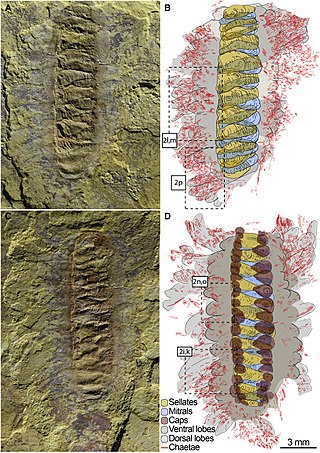
Wufengella is a genus of extinct camenellan "tommotiid" that lived during the Early Cambrian. Described in 2022, the only species Wufengella bengtsonii was discovered from the Maotianshan Shales of Chiungchussu (Qiongzhusi) Formation in Yunnan, China. The fossil indicates that the animal was an armoured worm that close to the common ancestry of the phyla Phonorida, Brachiozoa and Bryozoa, which are collectively grouped into a clade called Lophophorata.








